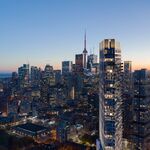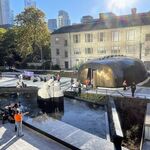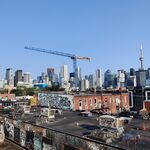Motions (City Council)
2 - Motion to Amend Item moved bymCouncillor Anthony Perruzza (Redundant)
That:
1. City Council amend Recommendation 12 by deleting the following words "as an interim measure, City Council approve area-based road closures - Draft Strategy #3 in Attachment A to the report (April 12, 2023) from the General Manager, Parks, Forestry and Recreation and the General Manager, Transportation Services; and direct the General Manager, Parks, Forestry and Recreation to continue the full closure of High Park to private visitor vehicles on Saturdays, Sundays and statutory holidays, exclusive of Spring Road parking lot, on an ongoing basis." so that it now reads as follows:
12. City Council approve full road closures at all times - Draft Strategy #1 in Attachment A to the report (April 12, 2023) from the General Manager, Parks, Forestry and Recreation and the General Manager, Transportation Services as the long term strategy for travel network improvements in High Park; as an interim measure, City Council approve area-based road closures - Draft Strategy #3 in Attachment A to the report (April 12, 2023) from the General Manager, Parks, Forestry and Recreation and the General Manager, Transportation Services; and direct the General Manager, Parks, Forestry and Recreation to continue the full closure of High Park to private visitor vehicles on Saturdays, Sundays and statutory holidays, exclusive of Spring Road parking lot, on an ongoing basis.
2. City Council direct that all roads within High Park remain open to all vehicles seven days a week during the implementation of the balance of the preferred strategy and until the full implementation of the accessible shuttle, the expansion of TTC operations to include year-round bus service, and the completion of accessibility upgrades at High Park subway station.
1 - Motion to Amend Item moved by Councillor Gord Perks (Carried)
That:
1. City Council delete Infrastructure and Environment Committee Recommendations 1 and 12:
Recommendations to be deleted
1. City Council approve the preferred strategy for travel network improvements in High Park as described in the report (April 12, 2023) from the General Manager, Parks, Forestry and Recreation and the General Manager, Transportation Services.
12. City Council approve full road closures at all times - Draft Strategy 1 in Attachment 1 to the report (April 12, 2023) from the General Manager, Parks, Forestry and Recreation and the General Manager, Transportation Services as the long term strategy for travel network improvements in High Park; as an interim measure, City Council approve area-based road closures - Draft Strategy 3 in Attachment 1 to the report (April 12, 2023) from the General Manager, Parks, Forestry and Recreation and the General Manager, Transportation Services; and direct the General Manager, Parks, Forestry and Recreation to continue the full closure of High Park to private visitor vehicles on Saturdays, Sundays and statutory holidays, exclusive of Spring Road parking lot, on an ongoing basis.
and adopt instead the following new Recommendations:
1. City Council approve full road closures at all times as the long term strategy for travel network improvements in High Park.
2. City Council amend the preferred strategy for travel network improvements in High Park as described in the report (April 12, 2023) from the General Manager, Parks, Forestry and Recreation and the General Manager, Transportation Services to include the full closure of High Park to private visitor vehicles on Saturdays, Sundays and statutory holidays, exclusive of Spring Road parking lot, on an ongoing basis, and approve the amended preferred strategy as an interim measure.
Vote (Amend Item) May-11-2023 11:49 AM
| Result: Carried | Majority Required |
|---|
| Total members that voted Yes: 18 | Members that voted Yes are Paul Ainslie, Brad Bradford, Alejandra Bravo, Jon Burnside, Shelley Carroll, Mike Colle, Paula Fletcher, Ausma Malik, Nick Mantas, Josh Matlow, Jennifer McKelvie, Chris Moise, Amber Morley, Jamaal Myers, Frances Nunziata (Chair), Gord Perks, Dianne Saxe, Michael Thompson |
| Total members that voted No: 7 | Members that voted No are Lily Cheng, Gary Crawford, Vincent Crisanti, Stephen Holyday, James Pasternak, Anthony Perruzza, Jaye Robinson |
| Total members that were Absent: 0 | Members that were absent are |
3 - Motion to Amend Item (Additional) moved by Councillor Paula Fletcher (Carried)
That City Council request the General Manager, Parks, Forestry and Recreation to include consideration of a shuttle for other parks in the development for the Request For Proposals for the renewed shuttle service in High Park described in Infrastructure and Environment Committee Recommendation 7.
Vote (Amend Item (Additional)) May-11-2023 11:50 AM
| Result: Carried | Majority Required |
|---|
| Total members that voted Yes: 21 | Members that voted Yes are Paul Ainslie, Brad Bradford, Alejandra Bravo, Jon Burnside, Shelley Carroll, Lily Cheng, Mike Colle, Gary Crawford, Vincent Crisanti, Paula Fletcher, Ausma Malik, Nick Mantas, Josh Matlow, Jennifer McKelvie, Chris Moise, Amber Morley, Jamaal Myers, Frances Nunziata (Chair), Gord Perks, Dianne Saxe, Michael Thompson |
| Total members that voted No: 4 | Members that voted No are Stephen Holyday, James Pasternak, Anthony Perruzza, Jaye Robinson |
| Total members that were Absent: 0 | Members that were absent are |
Motion to Adopt Item as Amended (Carried)
Vote (Adopt Item as Amended) May-11-2023 11:50 AM
| Result: Carried | Majority Required |
|---|
| Total members that voted Yes: 18 | Members that voted Yes are Paul Ainslie, Brad Bradford, Alejandra Bravo, Jon Burnside, Shelley Carroll, Mike Colle, Paula Fletcher, Ausma Malik, Nick Mantas, Josh Matlow, Jennifer McKelvie, Chris Moise, Amber Morley, Jamaal Myers, Frances Nunziata (Chair), Gord Perks, Dianne Saxe, Michael Thompson |
| Total members that voted No: 7 | Members that voted No are Lily Cheng, Gary Crawford, Vincent Crisanti, Stephen Holyday, James Pasternak, Anthony Perruzza, Jaye Robinson |
| Total members that were Absent: 0 | Members that were absent are |






